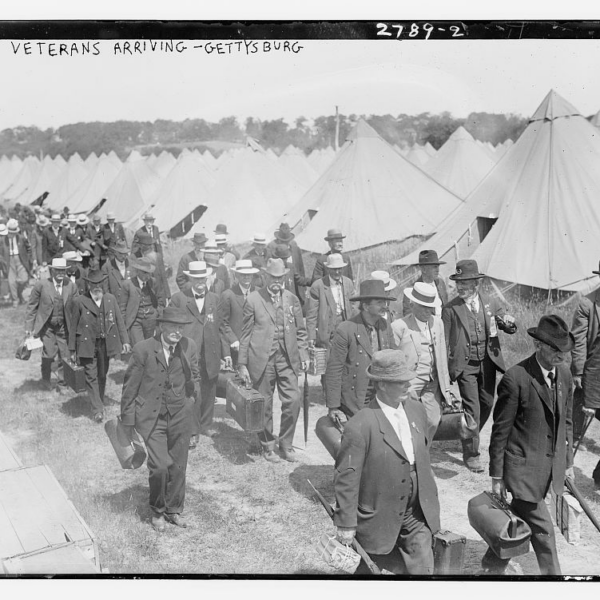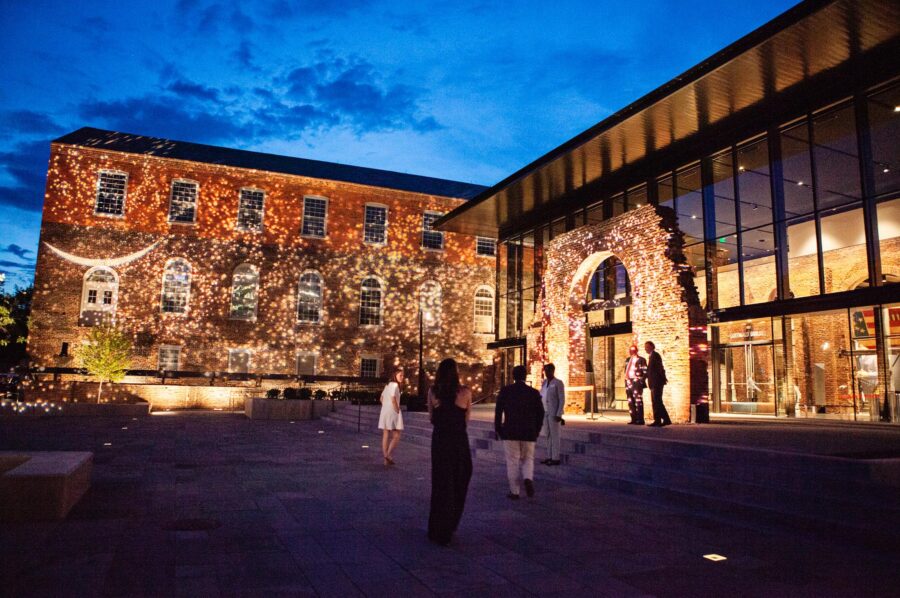 For Union veterans of the Civil War, the battlefield at Gettysburg served as the epicenter for war remembrance. The modern landscape certainly attests to this. A forest of marble, granite, and bronze—monuments to the Union cause—cover the rolling farmland and rocky hills of the area immediately surrounding the small Pennsylvania town where in the summer of 1863, two armies clashed in one of the war’s most epic battles. Stemming from the “high-tide” leitmotif so prevalent in the writings, speeches, and other commemorative efforts offered (by both Union and Confederate veterans) since the war’s end, the battlefield at Gettysburg is without contest the focal point of Civil War memory. While scholars have long debated both the utility and validity of singling out any one turning point in the war, Union veterans retrospectively looked to Gettysburg more than any other field in precisely this way—as the point where loyal citizens of the United States at last swept back the tide of the Confederacy.
For Union veterans of the Civil War, the battlefield at Gettysburg served as the epicenter for war remembrance. The modern landscape certainly attests to this. A forest of marble, granite, and bronze—monuments to the Union cause—cover the rolling farmland and rocky hills of the area immediately surrounding the small Pennsylvania town where in the summer of 1863, two armies clashed in one of the war’s most epic battles. Stemming from the “high-tide” leitmotif so prevalent in the writings, speeches, and other commemorative efforts offered (by both Union and Confederate veterans) since the war’s end, the battlefield at Gettysburg is without contest the focal point of Civil War memory. While scholars have long debated both the utility and validity of singling out any one turning point in the war, Union veterans retrospectively looked to Gettysburg more than any other field in precisely this way—as the point where loyal citizens of the United States at last swept back the tide of the Confederacy.
Scholars’ analysis of the commemorative efforts at Gettysburg rest squarely on the foundation of what I have termed the “reconciliation premise.” In short, this premise accents the shortcomings of reunion. David W. Blight’s profoundly influential Race and Reunion: The Civil War in American Memory offers a concise synopsis of this analytical tack. Blight reasons, together with white supremacists, reconciliationists “locked arms” and “delivered a segregated memory of the Civil War on Southern terms.” He concludes, “Forces of reconciliation overwhelmed the emancipationist vision in the national culture [and] the inexorable drive for reunion both used and trumped race.” Other influential historians—both prior to Race and Reunion and since—have come to similar conclusions. Gaines M. Foster, Edward Tabor Linenthal, Stuart McConnell and scores of others all suggest that reunion—often conflated with the notion of reconciliation—ushered in a commemorative spirit sans the issues of the war.1
Commemorative events at Gettysburg usually figure as central components to this argument. The 50th and 75th anniversaries of the battle—in 1913 and 1938—indeed did not feature any discussion of the salient war issues. These were instead “Blue-Gray” reunions—geared specifically to avoid confrontation and a rekindling of war wounds. But looking at such events alone obscures the principle thrust of Union commemorative events on the battlefield. Monument dedications and other speeches at Gettysburg overwhelming denote both the embittered indictment of the Confederacy and its cause as well as the celebratory bent of the victorious United States: the suppression of treason and the eradication of slavery. This was not mere gasconade offered by the victors over the vanquished. Rather, the overall Union commemorative spirit illustrated exactly what was a stake in 1863, and why victory at Gettysburg figured so paramount in veterans’ understandings of victory and the progress of their nation.
Several examples serve to illustrate the significance of the dual themes of Union commemoration at Gettysburg. Clinton Spencer, a veteran of the 1st Michigan Infantry, reminded his comrades attending the dedication of the Michigan monument in 1889: “We claim it to be our solemn duty here above this hallowed dust to proclaim and reiterate that disloyalty to the old flag was is and shall always be TREASON, deep, dark, and damnable, and the survivors of the Old 1st Michigan Infantry do not believe in palliating or shading in the least degree that definition of the term.”2
A year earlier—on the 25th anniversary of the battle, New York veteran and wealthy real estate developer Orlando B. Potter had offered similar statements. Speaking before veterans of the 83rd New York Infantry, Potter noted: “It has been said that the battles and victories of the late war ought not to be celebrated, because they were battles against and victories over our own countrymen.” Potter chose not to mention who might have desired this course of action. “I cannot agree with this sentiment,” stated Potter, “they were battles for the supremacy and preservation of our constitution and government. They were the last argument, rendered necessary by appeal from reason to force in the assault upon Fort Sumter, for the overthrow and annihilation of the fatal heresy of secession.”3
But the suppression of treason was not the only commemorative angle. Veterans also highlighted the cause of emancipation. Union veteran Benjamin F. Taylor concluded before a gathering of New Yorkers in 1888: “We can proudly say, ‘There is not a slave in all the broad domain.’ Already 4,000,000 of chattels have joined the wage-earners. Already is ignorance and superstition being supplanted by education and refinement. Already are the harvests of liberty being gathered from the fields of carnage.”4 Similarly, the previous year, New Jersey veterans showed considerable dedication to commemorating the cause of freedom. “This monument shall stand,” suggested one veteran of the 13th New Jersey Infantry, “among the many which are to be erected here, as a silent sentinel to indicate to future generations where soldiers of bravery and renown gave up their lives in defense of their country; to show where are the graves of the true patriots who dared to die for the hopes of man and the redemption of a race from slavery.”5
Many veterans paired the causes when offering commemorative speeches. Gettysburg, “this Calvary of American freedom,” as Pennsylvania veteran John A. Danks noted in 1889, maintained an important place in the memory of the fight for freedom and Union. In 1902, New York veteran Cornelius R. Parsons reminded the veterans of the Empire State’s 108th Regiment that he needed not discuss the soldiers’ “brave deeds or achievements” that played out on the field. Rather, “with no enmity for the foe lingering in our breasts,” the battle’s twin meanings in memory assumed the crux of Parsons’ speech. “I would not have any of those,” stated Parsons, “who have never before visited this sacred field forget that here was fought one of the greatest battles ever known, and here was won for the cause of Liberty and Union, for the cause of Freedom and Justice, a most substantial victory.”6
These voices are but a few of the many that resounded across the fields of Gettysburg through the latter part of the nineteenth century and the first quarter of the twentieth. Union veterans’ words suggest much more than a simple dismissal of the war’s issues for the sake of reconciliation. Rather, while we can conclude that reconciliation (the entire point of the Union war) informed the commemorative ethos in the North, we must also note the Union terms of said reconciliation—and what that means in the context of commemoration—stood in sharp relief against those of their former enemies.
M. Keith Harris, who holds a Ph.D. in U.S. History from the University of Virginia, hosts the blog Cosmic America: Civil War History and Memory.
Photo Credit: Library of Congress.
2 Clinton Spencer, “Address of Captain Clinton Spencer,” Michigan at Gettysburg, July 1st, 2nd, 3rd, 1863. June 12th 1889. Proceedings incident to he Dedication of the Michigan Monuments upon the Battlefield of Gettysburg, June 12th, 1889 (Detroit: Winn & Hammond, Printers and Binders, 1889), 72-73.
3 Orlando B. Potter, “Address of Hon. Orlando B. Potter,” New York Monuments Commission for the Battlefields of Gettysburg and Chattanooga — Final Report on the Battlefield of Gettysburg, 2 vols. (Albany, 1900), 2:670.
4 Benjamin F. Taylor, “Address of Benjamin F. Taylor, Dedication of the Monument to the Seventy-Sixth Regiment Infantry, July 1, 1888” New York Monuments Commission for the Battlefields of Gettysburg and Chattanooga, 2:611.
5 J. H. H. Love, “Dedication of the Monument to the Thirteenth New Jersey Volunteers, July 1, 1887: Address of General F. H. Harris, read by J. H. H. Love,” in State of New Jersey, Final Report of the Gettysburg Battle-field Commission, 1891(Trenton, 1891), 35.
6 John A. Danks, “Address of John A. Danks,” Pennsylvania at Gettysburg: Ceremonies of the Dedications of the Monuments 2 vols. (Harrisburg, 1893), 2:359; Cornelius R. Parsons, “Address of Cornelius R. Parsons,” Final Report on the Battlefield at Gettysburg 2 vols. (Albany, 1902), 2:786.
